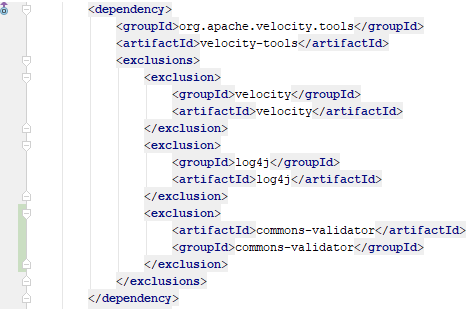How to manage Maven dependencies
When you create a Java project using Maven as a dependency management you can include all the dependencies that you want in your repository. A possible structure for your maven project can be a multi-module project where you have a pom parent and then you have a module for each layer that has your application.
- parent
- web-layer (servlets)
- service-layer (services, ejbs)
- model-layer (domain classes)
- store-layer (persistence classes)
- packaging (place to define how you package your ear)
Each one of this modules has its own pom.xml where you can define which dependencies you need for this module. You can end up adding in each module different dependencies that you need for each module, but maybe you are not aware of the transitive dependencies of each jar.
Problem - NoSuchMethodError in runtime
While you run your application in an application server like JBoss, Tomcat or Glassfish you get an exception because there’s a dependency conflict. You have more than one jar with the same class and it generates an exception while you run it that says NoSuchMethodError:
exception":{"class":"java.lang.NoSuchMethodError","message":"com.MetricsManager.getInstance()Lcom/MetricsManager;","stacktrace":"java.lang.NoSuchMethodError: com.MetricsManager.getInstance()Lcom/MetricsManagerHow can we fix this problem? This is because we have added dependencies in the poms of our application and we have not excluded the transitive dependencies that conflict with transitive dependencies of other jars.
Option 1 - Resolving conflicts with intellij-idea
Intellij has an option to see all the dependency tree of a module in a diagram with boxes and arrows.

Each box is a dependency that is connected with his dependencies. When there is a dependency conflict a red arrow appears. So what you have to do is to find the red arrows in the dependency tree and see which libraries are importing the same library.

To exclude transitive dependencies you can right click in the library and select exclude if you want to exclude a dependency.

And then you get in the pom.xml the dependency excluded.

Option 2 - Resolving conflicts using dependency plugin
The second option is to use this apache maven dependency plugin that allows you to check which are the conflictive versions inside of your ear. The plugin finds:
- Dependencies that are directly used but are not declared. (The project still compiles because it gets the dependencies transitively.)
- Dependencies that are declared but are unused.
mvn dependency:tree -Dverbose -Dincludes=commons-codec > output.txt[INFO] | | +- commons-httpclient:commons-httpclient:jar:3.0.1:compile
[INFO] | | | \- (commons-codec:commons-codec:jar:1.4:compile - omitted for duplicate)
[INFO] | | \- (commons-codec:commons-codec:jar:1.4:compile - omitted for duplicate)
[INFO] | \- org.jboss.resteasy:resteasy-jaxrs:jar:2.3.4.Final:compile
[INFO] | \- org.apache.httpcomponents:httpclient:jar:4.1.2:compile
[INFO] | \- (commons-codec:commons-codec:jar:1.4:compile - omitted for duplicate)Option 3 - Resolving conflicts checking jars in the ear file
Another option can be to check manually the libs that you have inside the ear file. You should check the lib folders and review visually if you have equal jar names with different versions.
Good practice - using dependency management
A good practice is to define in the pom parent the dependencies that you will use in your maven project and the version numbers. This way if you use a dependency in more than one module of your repository you will use the same version in all the modules.
This is the parent pom.xml
<dependencyManagement>
<dependencies>
<dependency>
<dependency>
<groupId>javax.servlet</groupId>
<artifactId>javax.servlet-api</artifactId>
<version>[3.1.0]</version>
<scope>provided</scope>
</dependency>
<dependency>
<groupId>log4j</groupId>
<artifactId>log4j</artifactId>
<version>[1.2.17]</version>
</dependency>
</dependencies>
</dependencyManagement>This is the pom.xml of the web-layer. Notice that you are not defining the version number of the dependency because is defined in the parent pom.
<dependencies>
<dependency>
<dependency>
<groupId>javax.servlet</groupId>
<artifactId>javax.servlet-api</artifactId>
</dependency>
</dependencies>Conclusion
The dependencies of your Java application should be managed carefully because you can get surprises while running your application. We have seen three ways to approach this problem and a good practice to organize your pom files with dependencyManagement in your parent pom.

Comments